Zippers, Seals, Valves & Maintenance
There's no doubt about it, drysuits require a great deal more maintenance than wetsuits. However, much of it is well within the capabilities of a home handyman with readily available materials and tools. The following guide should give some idea of what is involved in owning a drysuit, although there is no need for you to do these things yourself if you don't want to!
Zipper
The waterproof zipper of a drysuit is a really neat device. It is quite different from a normal clothing zipper, and exactly how it works is not obvious. Here are some close-ups of an old zipper that I cut up:
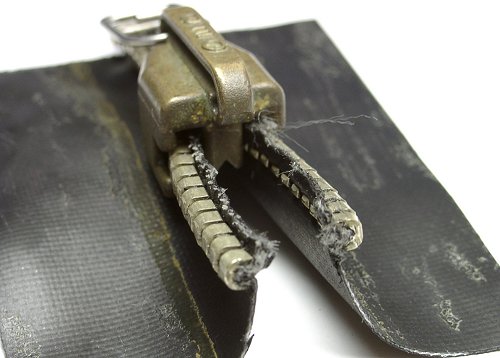
This is the view you see most of the time - the zipper pull from the outside. Note how the rubberized material is folded inside the teeth of the zipper. Also, note the stray fibers peeling off this worn-out zipper.
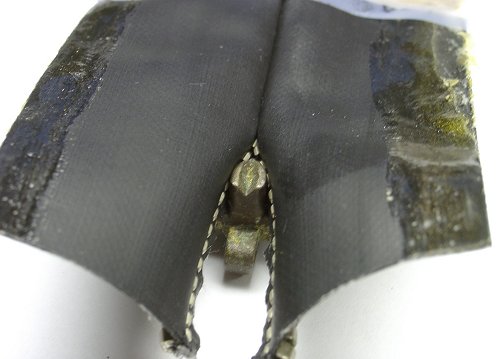
This is the same part viewed from the inside. The zipped-up section shows how the inner teeth on each side interlock, pressing the material tightly together to form a waterproof seal.
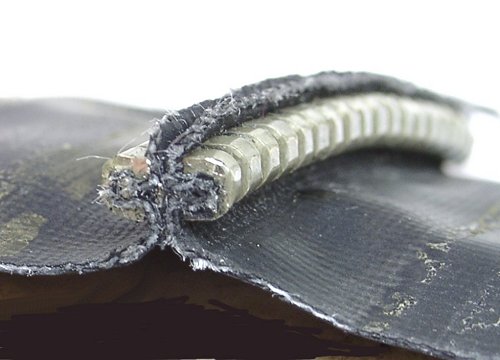
On this cut section of zipper, you can see that there is actually a double seal - both inside and outside the teeth. As near as I can tell, the teeth do not actually pierce the material anywhere - it is clamped around them. The inner part of the teeth interlock, drawing the surrounding rubberized fabric closely together.
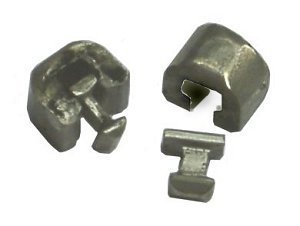
Finally, the brass zipper teeth themselves, at right. The outer part of each zipper tooth is merely a clamp to hold the inner part in place and guide the pull. It is the small inner part of the tooth that actually does all the work, holding the zipper shut, while the surrounding material forms the seal. Therefore, when waxing your zipper, be sure to do the inside as well as the outside. Not shown are the molded rubber stops at each end of the zipper which assure that the ends are watertight.

This type of pressure-sealing zipper was originally developed for the space program, where it was used in high-altitude pilot's flight suits and early astronaut suits ( although current Space Shuttle suits do not use zippers for seals. ) At right is a 1950s-era Mercury pressure suit. The zipper, plainly evident diagonally across the front of the suit, would be familiar to any drysuit diver. On a spacesuit, the purpose of the zipper is to hold a higher pressure inside the suit, while on a diving suit, there is normally very little pressure differential, and the zipper is merely required to keep the water out.
Drysuits existed long before the invention of the waterproof zipper. These suits are generally sealed up using flaps of rubber around an entrance slit. The two flaps were brought together and rolled up to form a seal. This type of diving suit actually predates the wetsuit, which could not have come into existence before the invention of foam rubber after World War Two.
Repairs & Replacement
Drysuit zippers eventually begin to leak, as the material unravels along the outside edge from repeated use. Zippers can also fail outright if a tooth pulls out. Zipper life can be extended by regular waxing, both inside and out. Sometimes, an apparent zipper leak may actually be a seam leak. This is easily fixed with AquaSeal. Zipper replacement does not look all that difficult, but given the price of a good zipper - $200-$300 - and the possibility of ruining it if you screw up the installation, I would leave this job to a shop.
Valves & Inflator Hose
Drysuit inflator valves are simple devices that generally do not fail. I had one begin to leak once, and no attempt at servicing it would make it stop, despite the fact that I could see nothing apparently wrong with it. Replacement is simple, however, and parts should be available from your dealer. Valves are sealed onto the suit using RTV silicone, not AquaSeal. The clear stuff from the auto parts store works fine. Likewise, exhaust valves are simple to replace but difficult to service. In fact, the typical drysuit exhaust valve is a fiendishly clever device ( it is actually an adjustable double one-way valve in a single body ) that is very difficult to properly reassemble, so I don't recommend trying to service one. Don't overlook the possibility that an apparently leaky valve may actually be a suit puncture near the valve!
Ever price a replacement DUI inflator hose? $65 !!! Now I happen to like the big fat knob on the DUI hose - if you ever need to disconnect a runaway suit inflator, that will do the trick much better than a small knurled BC inflator, But I don't like that price. So when your DUI inflator hose wears out, just buy a regular $20 inflator hose, and transplant the DUI knob ( and the beefier DUI spring ) onto it. The parts fit right on, and the job takes about 5 minutes if you are handy.
Wrist & Neck Seals
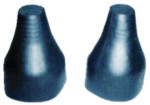 Latex Cone Type Regular & Heavy-duty | 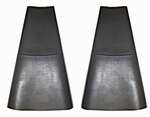 Latex Long (DUI 'RS') Type Heavy-duty only | 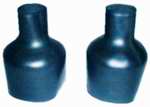 Latex Bottle Type Regular & Heavy-duty |
There are several styles of drysuit wrist seals. The options are material, weight, and shape.
Most drysuits come from the factory with lightweight latex rubber cone-style wrist seals, pictured above at left. These have just a narrow contact area around the wrist to make the waterproof seal. When this narrow band stretches from use, the seal leaks and must be replaced. Some manufacturers offer options in wrist and neck seals.
Long-style seals have a much longer tapered skin-to-seal contact area, for a more leak-proof and longer-lasting seal. These seals are bi-thickness - heavier at the base where the seal attaches to the suit sleeve, and thinner near the end where your hand goes through ( although still much thicker than a regular-weight seal. ) DUI refers to this style of seal as "RS", for "Rubber Suit."
Bottle-type seals have a large untapered contact area. While the lack of taper makes them very easy to get on and off, it also means that the seal must be sized precisely to your wrist, and when it stretches from wear it will leak, assuming it did not leak from the beginning.
Neoprene wrist seals ( not shown ) are much longer-lasting than any latex. They are also easier to get on and off, although not as watertight. Sometimes a neoprene seal is used over a latex one, for a double seal. Dry gloves are yet another option.
Heavy-duty latex ( and neoprene ) seals are easier to put on than thin regular-weight latex seals. Unlike thin regular-weight seals, which roll up annoyingly and require much fiddling-with to get them to lie flat, with heavy-duty seals you just shove your hand through and you're done. All styles of heavy-duty seals are referred to variously ( and confusingly ) as military and/or commercial.
My own preference is for long, tapered, heavy-duty latex wrist seals.
All latex seals begin to degrade immediately after manufacture, eventually turning gummy, stretching, and finally tearing. My records show that heavy-weight seals are not particularly longer-lasting than normal-weight seals - 12 to 18 months is a typical life expectancy. Neoprene seals last longer - several years may be expected, but repeated stretching will eventually cause a neoprene seal to take a permanent set, at which point it will have to be replaced.
Repairs & Replacement
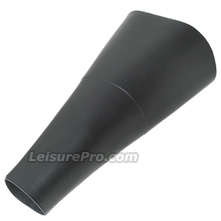
Replacing latex wrist seals is a fairly straightforward operation that can easily be tackled at home if you are reasonably handy. The DUI Drysuit Repair Guide gives complete instructions on the matter. Replacing neoprene wrist seals is more difficult, as they properly ought to be stitched on. One option is to simply cut off a worn set of neoprene seals and replace them with latex.
Replacement wrist seals may be ordered from DUI, or Leisure Pro. Leisure Pro generally stocks the fine-looking heavyweight cone-style seals pictured at right, by Bare, part # BRE69397. These cost about $25 / pair, and will usually arrive overnight to NJ by any shipping method. I keep an extra set on hand at all times. All rubber products have a definite shelf life, as deterioration starts immediately after manufacture, whether they are used or not. Shelf life of all rubber products, as well as cements, can be greatly extended by storing in your freezer.
There are some things you can do to extend the life of old seals before they ultimately need to be replaced:
Latex seals deteriorate differently at each end: the base will typically dry-rot and crack where it joins the suit sleeve, while the end will turn gummy and sticky and eventually tear. Cracks at the base can be covered over with AquaSeal, thinned 50-50 or more with Cotol so that it adheres to the Latex. ( AquaSeal doesn't really like to stick to latex, but if it is thinned enough, it will stay on for a while. ) This is an ugly repair that is really just temporary, so don't get the AquaSeal on the suit itself, just on the seals. Also, sometimes the AquaSeal on the inside of the seal-sleeve joint comes loose and begins to leak. Turn the sleeve inside out, and strip and reseal anything that looks bad. Small punctures in latex seals may be repaired with glueless bicycle patch kits.
At the other end of the seal, stickiness may be smoothed out with any of the available "Seal Saver" products, which are really just silicone lubes. This may also restore some stretch and suppleness. Do not get this stuff anywhere near the base of the seal where it meets the sleeve, just apply it around the ends, inside and out. Oiling up the end of the drysuit sleeve will make it much more difficult to adhere a new seal when the time comes. This is again just a temporary measure.
Neoprene seals may be serviced as well: when the seal has stretched and started to leak, cut a long narrow V-notch from the end to the base, cutting out the old seam in the process. The notch should be about 1/4 " wide at the outside edge. Then, using as little neoprene cement as possible, butt-join the two edges of the notch, to make a new narrower cone. Back the joint with a small amount of thinned AquaSeal. You probably won't get away with this trick more than once, as eventually, the neoprene will lose so much of its stretch that it will have to be replaced outright, but it may add a year or more of life. Punctures in neoprene seals may be repaired the same as suit punctures, and "Seal Saver" may also be applied as described above.
Neck Seals
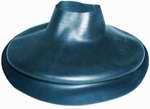
Everything said above concerning wrist seals also applies to neck seals ( right. ) Neck seals have similar life expectancies, and repair and replacement is also generally similar, although replacing a big neck seal is much more difficult than replacing a small wrist seal. Getting one of these on straight takes some dexterity and cleverness, especially since you only have one shot at it! If you'd like to try, replacement neck seals are available from DUI. With roll-under neoprene neck seals, the notching trick works especially well.
Storage
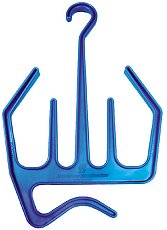
Many of the odd-looking hangers you can get at the dive shop are actually very useful. Hanging up foam neoprene items is much better than storing them flat or folded, which can make permanent creases and crush spots. Upright hanging also allows items to dry faster and more thoroughly. Keep rubber items away from fumes and ozone - i.e. a clothes closet is a much better place than a garage.
At right is an accessory hanger on which you can store and dry gloves, boots, and hood. Below are two suit hangers. The hugely flared shoulders on the drysuit hanger allow air to circulate inside, and also spread the weight of the suit across a large area, avoiding pinched corners. The less expensive wetsuit hanger is perfect for drysuit underwear as well. Shell-type underwear should be hung up inside-out.
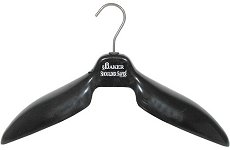 "Shoulder-saver" Drysuit hanger | 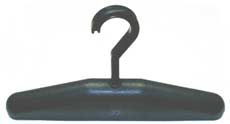 Wetsuit / underwear hanger |
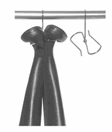
Suits should be stored with zippers open. If your drysuit has suspenders inside, do not hang them on the hanger. This will only wear them out prematurely; the suit material is plenty strong enough to support itself.
The foot-hanger at right is used to hang a drysuit upside-down from the boots, allowing it to drain through the neck and arms. This is useful when cleaning the suit, both inside and out, although it should not be used for long-term storage. Leisure Pro sells them.



